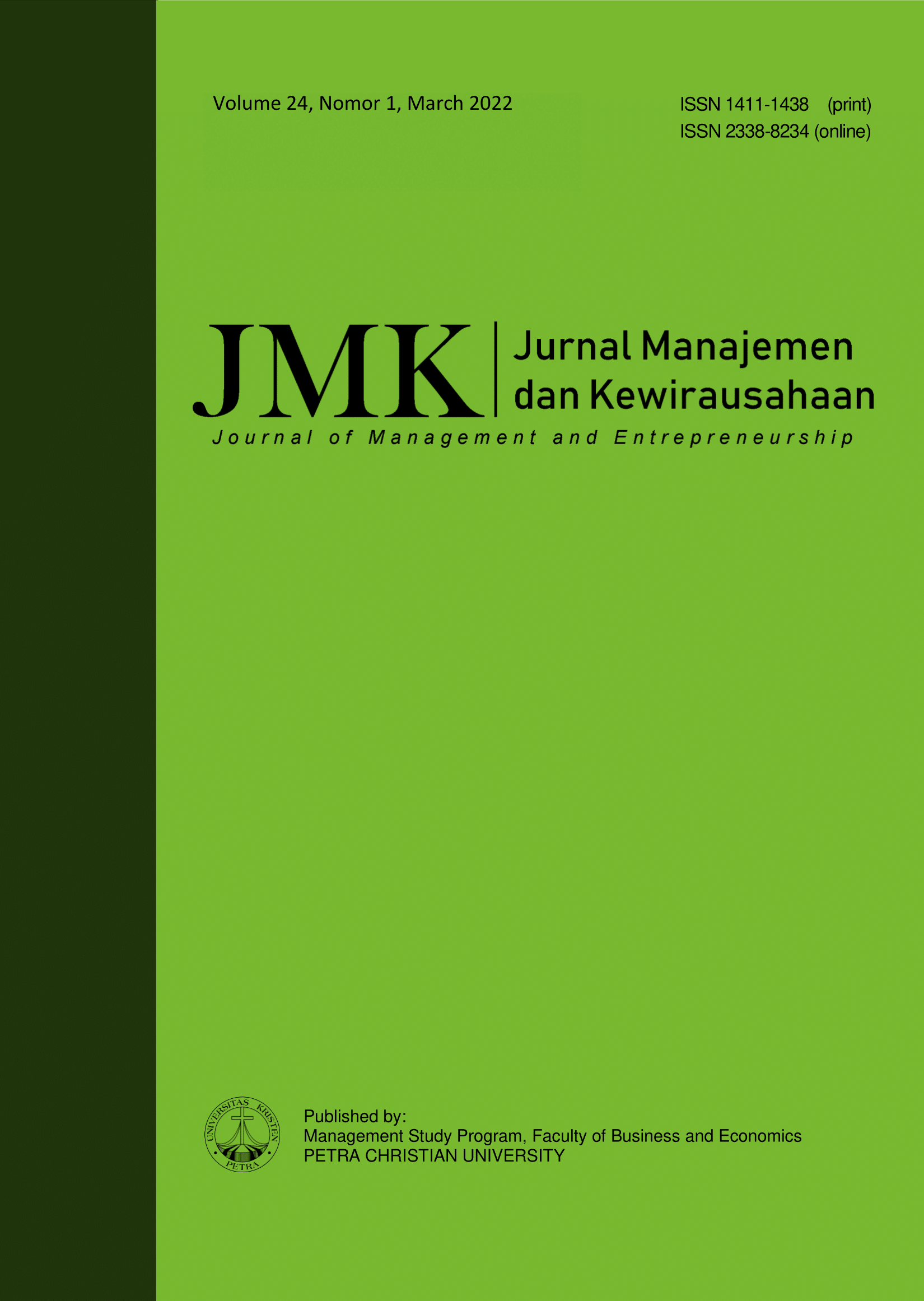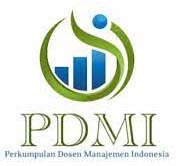EXCHANGE RATE, GOLD PRICE, AND STOCK PRICE CORRELATION IN ASEAN-5: EVIDENCE FROM COVID-19 ERA
 :
:
https://doi.org/10.9744/jmk.24.1.22-32
Keywords:
Exchange rate, gold price, stock price, ASEAN-5, ADCC-GARCH, COVID-19Abstract
ASEAN-5 (Indonesia, Singapore, Malaysia, Philippines, and Thailand) were the pillars of economies in the Southeast Asia. This study aimed to examine the dynamic correlation of exchange rate and gold price on stock price in ASEAN-5 countries during COVID-19 pandemic. This study used Asymmetric DCC-GARCH model and employed daily data from March 2020 to August 2021. For all cases, the findings showed the degree of correlations were similar to each other. Furthermore, the result revealed that exchange rate and gold price had weak correlations on stock price. During the pandemic, negative correlation confirmed the exchange rate was a better alternative asset than gold which was positively correlated with stock prices. The ASEAN-5 market participants should hereby evaluated their investment risk and strategy.
References
Akram, M. U., Malik, K. Z., Imtiaz, A., Aftab, A., & Chen, M. (2020). Forex and financial markets dynamics: A case of China and ASEAN. Cogent Economics & Finance, 8(1), 1756144. https://doi. org/10.1080/23322039.2020.1756144
Al-Ameer, M., Hammad, W., Ismail, A., & Hamdan, A. (2018). The relationship of gold price with the stock market: The case of frankfurt stock ex-change. International Journal of Energy Eco-nomics and Policy, 8(5), 357–371.
Al-Awadhi, A. M., Alsaifi, K., Al-Awadhi, A., & Al-hammadi, S. (2020). Death and contagious in-fectious diseases: Impact of the COVID-19 virus on stock market returns. Journal of Be¬havioral and Experimental Finance, 27, 100 326. https: //doi.org/10.1016/j.jbef.2020.1003 26
Ali, M., Alam, N., & Rizvi, S. A. R. (2020). Co-ronavirus (COVID-19) – An epidemic or pande-mic for financial markets. Journal of Behavioral and Experimental Finance, 27, 100341. https:// doi.org/10.1016/j.jbef.2020.100 341
Asaad, Z. A. (2021). Oil price, gold price, exchange rate and stock market in Iraq preduring CO-VID19 outbreak: An ARDL approach. International Journal of Energy Economics and Policy, 11(5), 562–571. https://doi.org/10.32479/ijeep.1 1552
ASEAN Secretariat, & UNCTAD Division on In-vestment and Enterprise. (2021). ASEAN in-vestment report 2020–2021 (Issue September). https://asean.org/wp-content/uploads/2021/09/A IR-2020-2021.pdf
Baker, S., Bloom, N., Davis, S., Kost, K., Sammon, M., & Viratyosin, T. (2020). The unprecedented stock market impact of COVID-19. NBER Work-ing Paper. https://doi.org/10.3386 /w26945
Barakat, M. R., Elgazzar, S. H., & Hanafy, K. M. (2015). Impact of macroeconomic variables on stock markets: Evidence from emerging markets. International Journal of Economics and Finance, 8(1), 195. https://doi.org/10.55 39/ijef.v8n1p195
Baruník, J., Kočenda, E., & Vácha, L. (2016). Gold, oil, and stocks: Dynamic correlations. International Review of Economics and Finance, 42, 186–201. https://doi.org/10.1016/j.iref.2015.08. 006
Baur, D. G., & Lucey, B. M. (2010). Is gold a hedge or a safe haven? An analysis of stocks, bonds and gold. Financial Review, 45(2), 217–229. https://doi.org/10.1111/j.1540-6288.2010.00 244.x
Baur, D. G., & McDermott, T. K. (2010). Is gold a safe haven? International evidence. Journal of Bank-ing and Finance, 34(8), 1886–1898. https://doi. org/10.1016/j.jbankfin.2009.12.008
Cao, K. H., Li, Q., Liu, Y., & Woo, C.-K. (2020). COVID-19’s adverse effects on a stock market index. Applied Economics Letters, 1–5. https: //doi.org/10.1080/13504851.2020.1803481
Cappiello, L., Engle, R. F., & Sheppard, K. (2006). Asymmetric dynamics in the correlations of global equity and bond returns. Journal of Financial Econometrics, 4(4), 537–572. https:// doi.org/10.1093/jjfinec/nbl005
Chandrashekar, R., Sakhtivel, P., Sampath, T., & Chittedi, K. R. (2018). Macroeconomic variables and stock prices in emerging economies: A panel analysis. Theoretical and Applied Economics, XXV(3), 91–100.
Chkili, W. (2016). Dynamic correlations and hedging effectiveness between gold and stock markets: Evidence for BRICS countries. Research in International Business and Finance, 38, 22–34. https://doi.org/10.1016/j.ribaf.201 6.03.005
Ding, W., Levine, R., Lin, C., & Xie, W. (2020). Corporate immunity to the COVID-19 pandemic. In NBER Working Paper. https://doi.org/10.3386/ w27055
Donthu, N., & Gustafsson, A. (2020). Effects of COVID-19 on business and research. Journal of Business Research, 117(June), 284–289. https://doi.org/10.1016/j.jbusres.2020.06.008
Engle, R. (2002). Dynamic conditional correlation: A simple class of multivariate generalized autoregressive conditional heteroskedasticity models. Journal of Business and Economic Sta¬tis¬tics, 20 (3), 339–350. https://doi.org/10.1198/07350010 2288618487
Glosten, L. R., Jagannathan, R., & Runkle, D. E. (1993). On the relation between the expected value and the volatility of the nominal excess return on stocks. The Journal of Finance, 48(5), 1779–1801. https://doi.org/10.1111/j.1540-6261.1993. tb05128.x
Ibrahim, M. H. (2012). Financial market risk and gold investment in an emerging market: The case of Malaysia. International Journal of Islamic and Middle Eastern Finance and Management, 5(1), 25–34. https://doi.org/10.1108/mf.2008.00934ja a.001
Iqbal, J. (2017). Does gold hedge stock market, inflation and exchange rate risks? An econome¬tric investigation. International Review of Economics and Finance, 48(July 2014), 1–17. https://doi. org/10.1016/j.iref.2016.11.005
Jain, A., & Biswal, P. C. (2016). Dynamic linkages among oil price, gold price, exchange rate, and stock market in India. Resources Policy, 49, 179–185. https://doi.org/10.1016/j.resourpol.2016.06. 001
Ji, Q., Zhang, D., & Zhao, Y. (2020). Searching for safe-haven assets during the COVID-19 pandemic. International Review of Financial Ana-lysis, 71, 101526. https://doi.org/10.1016/j.irfa.2 020.101526
Joy, M. (2011). Gold and the US dollar: Hedge or haven? Finance Research Letters, 8(3), 120–131. https://doi.org/10.1016/j.frl.2011.01.001
Junttila, J., Pesonen, J., & Raatikainen, J. (2018). Commodity market based hedging against stock market risk in times of financial crisis: The case of crude oil and gold. Journal of International Financial Markets, Institutions and Money, 56, 255–280. https://doi.org/10.1016/j.intfin.2018. 01.002
Iyke, B. N. (2020). The disease outbreak channel of exchange rate return predictability: Evidence from COVID-19. Emerging Markets Finance and Trade, 56(10), 2277–2297. https://doi.org /10.1080/1540496X.2020.1784718
Kang, S. H., Uddin, G. S., Troster, V., & Yoon, S.-M. (2019). Directional spillover effects between ASEAN and world stock markets. Journal of Multinational Financial Management, 52–53, 100592. https://doi.org/10.1016/j.mulfin.2019. 100592
Kocaarslan, B., Sari, R., Gormus, A., & Soytas, U. (2017). Dynamic correlations between BRIC and U.S. stock markets: The asymmetric impact of volatility expectations in oil, gold and financial markets. Journal of Commodity Markets, 7, 41–56. https://doi.org/10.1016/j. jcomm.2017.08.001
Mishra, P. K., & Mishra, S. K. (2020). Corona pan-demic and stock market behaviour: Empirical insights from selected Asian countries. Millennial Asia, 11(3), 341–365. https://doi.org/10.1177/09 76399620952354
Mohapatra, S. M., & Rath, B. N. (2015). Do macro-economic factors matter for stock prices in emerging countries? Evidence from panel co-integration and panel causality. International Journal of Sustainable Economy, 7(2), 140. https://doi.org/10.1504/IJSE.2015.068678
Morema, K., & Bonga-Bonga, L. (2020). The impact of oil and gold price fluctuations on the South African equity market: Volatility spillovers and financial policy implications. Resources Policy, 68(July 2019), 101740. https://doi.org/10.1016/ j.resourpol.2020.101740
Narayan, P. K., Devpura, N., & Wang, H. (2020). Japanese currency and stock market—What happened during the COVID-19 pandemic? Economic Analysis and Policy, 68, 191–198. https://doi.org/10.1016/j.eap.2020.09.014
Nwosa, P. I. (2021). Oil price, exchange rate and stock market performance during the COVID-19 pandemic: Implications for TNCs and FDI inflow in Nigeria. Transnational Corporations Review, 13(1), 125–137. https://doi.org/10.1080/19186 444.2020.1855957
O’Connor, F. A., Lucey, B. M., Batten, J. A., & Baur, D. G. (2015). The financial economics of gold — A survey. International Review of Financial Analysis, 41, 186–205. https://doi.org/10.1016/j. irfa.2015.07.005
Phan, D. H. B., & Narayan, P. K. (2020). Country responses and the reaction of the stock market to COVID-19 - A preliminary exposition. Emerging Markets Finance and Trade, 56 (10), 2138–2150. https://doi.org/10.1080/1540496X.2020. 1784719
Qamruzzaman, Mehta, A. M., Khalid, R., Serfraz, A., & Saleem, H. (2021). Symmetric and asymmetric effects of financial innovation and FDI on ex-change rate volatility: Evidence from south Asian countries. Journal of Asian Finance, Economics and Business, 8(1), 023–036. https ://doi.org/10.13106/jafeb.2021.vol8. no1.023.
Rai, K., & Garg, B. (2021). Dynamic correlations and volatility spillovers between stock price and ex-change rate in BRIICS economies: Evidence from the COVID-19 outbreak period. Applied Economics Letters, 00(00), 1–7. https://doi.org/10.1080/13504851.2021.1884835
Rajwani, S., & Kumar, D. (2016). Asymmetric dynamic conditional correlation approach to financial contagion: A study of Asian markets. Global Business Review, 17(6), 1339–1356. https://doi. org/10.1177/0972150916660400
Robiyanto, R., Santoso, M., Rambu Atahau, A., & Harijono, H. (2019). The Indonesia stock ex-change and its dynamics: An analysis of the effect of macroeconomic variables. Montenegrin Journal of Economics, 15(4), 59–73. https://doi.org/ 10.14254/1800-5845/2019.15-4.5
Robiyanto, R., Wahyudi, S., & Pangestuti, I. R. D. (2017a). The volatility–variability hypotheses testing and hedging effectiveness of precious metals for the Indonesian and Malaysian capital markets. Gadjah Mada International Journal of Business, 19(2), 167–192. https://doi.org/10.22146/gamaijb.26260
Robiyanto, R., Wahyudi, S., & Pangestuti, I. R. D. (2017b). Testing commodities as safe haven and hedging instrument on ASEAN’s five stock mar-kets. Jurnal Ekonomi Kuantitatif Terapan, 10(2), 231–238. https://doi.org/10.24843/JEKT. 2017.v 10.i02.p11
Shahrier, N. A., Subramaniam, N. R., & Ariff, M. (2020). COVID-19 challenges to ASEAN-5 cur-rencies dynamic linkages: Unity or disunity? SSRN Electronic Journal. https://doi.org/10.21 39/ssrn.3708263
Siddiqui, S., & Roy, P. (2019). Predicting volatility and dynamic relation between stock market, ex-change rate and select commodities. Acta Universitatis Agriculturae et Silviculturae Mendelianae Brunensis, 67(6), 1597–1611. https://doi.org/10.11118/actaun201967061597
Surbakti, E. H., Achsani, N. A., & Maulana, T. N. A. (2016). The impact of macroeconomic va¬riables on JCI’s stock return volatility in pre and post global economic crisis. International Journal of Scientific and Research Publications, 6(3), 213–220.
Syahri, A., & Robiyanto, R. (2020). The correlation of gold, exchange rate, and stock market on COVID-19 pandemic period. Jurnal Keuangan dan Perbankan, 24(3), 350–362. https://doi.org/ 10.26905/jkdp.v24i3.4621
Thaker, H. M. T., & Sakaran, K. C. (2021). COVID-19, financial markets (Islamic vs non-Islamic), and exchange rate: Does the Malaysian market offers diversification opportunities to the in¬ves-tors? Global Review of Islamic Economics and Business, 9(1), 19–27. https://doi.org/10.14421/ grieb.2021.%25x
United Nations. (2020). Global humanitarian response plan. March. https://www.unocha.org/ sites/unocha/files/Global-Humanitarian-Resp onse-Plan-COVID-19.pdf
Vejzagic, M., & Zarafat, H. (2013). Relationship bet-ween macroeconomic variables and stock market index: Cointegration evidence from FTSE bursa Malaysia hijrah shariah index. Asian Journal of Management Sciences & Education, 2(4), 94–108.
Vinayak, H., Thompson, F., & Tonby, O. (2014). Understanding ASEAN: Seven things you need to know. McKinsey&Company, 2013 (Ex¬hibit 1), 1–8. http://www.mckinsey.com/industries/public- sector/our-insights/understa nding-asean-seven-things-you-need-to-know
Wen, X., & Cheng, H. (2018). Which is the safe haven for emerging stock markets, gold or the US dollar? Emerging Markets Review, 35, 69–90. https://doi.org/10.1016/j.ememar.2017.12. 006
World Health Organization. (2020). Critical preparedness , readiness and response actions for COVID-19. March. https://www.who.int/publications/i/item/critical-preparedness-readiness-and-response-actions-for-covid-19
Zhafira, Z., Evana, E., & Septiyanti, R. (2021). The effect of exchange value on the stock index listed in Indonesia stock exchange during COVID-19 pandemic. Journal Dimensie Mana¬ge¬ment and Public Sector, 2(1), 6–14. https://doi.org/10.481 73/jdmps.v2i1.62
Zhang, D., Hu, M., & Ji, Q. (2020). Financial markets under the global pandemic of COVID-19. Finance Research Letters, 36(March), 10152 8. https://doi.org/10.1016/j.frl.2020.101528
Downloads
Published
How to Cite
Issue
Section
License
Authors who publish on this journal agree to the following terms:
- Authors retain copyright and grant the journal right of first publication with the work simultaneously licensed under a Creative Commons Attribution License that allows others to share the work with an acknowledgement of the work's authorship and initial publication in this journal.
- Authors are able to enter into separate, additional contractual arrangements for the non-exclusive distribution of the journal's published version of the work (e.g., post it to an institutional repository or publish it in a book), with an acknowledgement of its initial publication in this journal.
- Authors are permitted and encouraged to post their work online (e.g., in institutional repositories or on their website) prior to and during the submission process, as it can lead to productive exchanges, as well as earlier and greater citation of published work (See The Effect of Open Access).


















